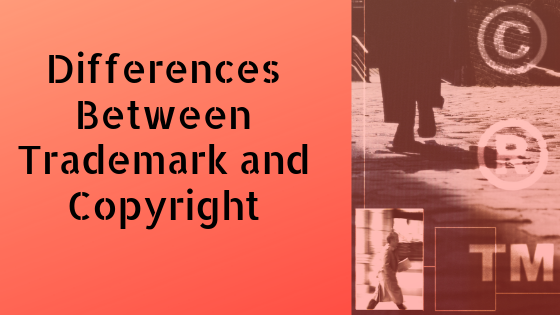
Differences Between Trademark and Copyright
A common question asked by business owners, authors, and creative individuals is whether they need a copyright or a trademark to protect their work. This is because many aren’t aware of the differences between trademarks and copyright and which one is appropriate for what they want to protect.
But, the intellectual property rights you have in a trademark or copyright may be the most valuable asset you own. Therefore, they need to be protected. Understanding the differences between a copyright and a trademark is the first step in properly protecting your interests.
Intellectual Property
Intellectual property (IP) is at the core of copyright and trademark law. IP is embodied in creative works like writings, music, sculptures, paintings, or drawings; in words, symbols, and phrases; and even in new inventions and processes.
The three fundamental types of intellectual property are:
- Trademarks;
- Copyrights; and
- Patents
The rest of this article will focus on the difference between trademarks and copyrights only.
What is Copyright?
A copyright is a form of intellectual property protection provided for almost every kind of creative expression, including:
- Paintings;
- Sketches;
- Writings;
- Sheet music;
- Video and audio recordings;
- Sculptures;
- Architectural designs;
- Computer software; and
- Other written or creative works
For copyright to exist in a work, it has to be fixed in a “tangible medium”, meaning that it must already exist in some perceptible form, such on paper, in a sound or video recording, or embodied in a painting or sculpture.
Copyright protection is available for both published and unpublished works and, in general, gives the owner of the copyright the legal right to exclude others from using or reproducing their work without the owner’s permission.
A copyright is automatically conferred the moment a work is created. However, there are certain advantages to registering a copyright, such as the ability to prove that you are the original creator through documentation.
A copyright grants the owner exclusive rights in the way that an idea is expressed. But, it does not confer any rights in the idea itself.
For instance, if you were to write an article about a particular car, the text in that article would be protected by copyright, preventing anyone else from using those same words in the same order. However, this doesn’t preclude someone else from writing their own original article about the same car, or from using or producing a car just like the one described in your article.
Lastly, copyrights do not protect short phrases, titles, or common design elements. These types of assets are usually protected as trademarks, which are often confused with copyrights.
What is a Trademark?
A trademark is a form of intellectual property protection that covers symbols, names, logos, words, and devices that are used to identify the goods or services of one business entity from the goods or services of another. Trademarks are intended to protect consumers from confusion and to protect the interests of the trademark holder as well.
When a business produces a particular product and registers a trademark for that product with the proper governmental agency, no other business can use that trademark in association with their own products. Examples of trademarks include:
- “Google”;
- “Coca-Cola”;
- “Clorox”;
- “Exxon”;
- The Nike swoosh;
- Starbucks’s mermaid;
- The font used in the name “Walt Disney”;
- The NBC peacock; and even
- The NBC chimes.
In order to qualify as a trademark, the mark has to be distinguishable from other marks. So, when choosing your trademark, it is best to choose a word, symbol, or phrase that is distinctive.
Trademark protection accrues as soon as you begin to use a name, symbol, logo, etc. in association with your products or services. Thus, like a copyright, a trademark does not have to be registered. However, having your trademark registered with the proper government authority can be a huge advantage, especially when it comes to proving ownership and enforcing your rights in the trademark.
The Gray Area Between Trademark and Copyright Protection?
On the surface, trademarks and copyrights may appear to be almost the same thing. But, in reality, they are not.
A copyright protects the unique expression of an idea, while a trademark is intended to differentiate the particular goods and services of one company from those of another. The main source of confusion between trademarks and copyrights is the fact that a trademark can also be copyrighted if it also embodies a creative expression.
For example, the infamous Nike swoosh identifies products produced by the Nike company from similar products made by other companies, such as Adidas, Converse, or Puma. Thus, the Nike swoosh is a trademark. However, because (in its form and shape) it is a unique expression of an idea, it can also be protected by a copyright.
Conclusion
In simple terms, copyrights and trademarks are both types of intellectual property protection provided to businesses, authors, artists, and others. But, they differ in the subject matter of the protection they provide.
Copyrights grant exclusive rights to the authors of creative works, while trademarks generally protect marks used to indicate the source of goods and services, and are meant to protect the interests of consumers, as well as, the trademark holders.
However, whenever a trademark embodies creative originality, such as with a logo design or an illustrated character, it can be the subject of both a copyright and trademark protection.
For More Information, Contact Trademark Angel
To find out if a trademark or copyright is best to protect your intellectual property interests, call Trademark Angel 226.246.2979 or visit our contact page to request a consultation. We register trademarks in the US, Canada, the United Kingdom, the European Union, Australia, China and India.





